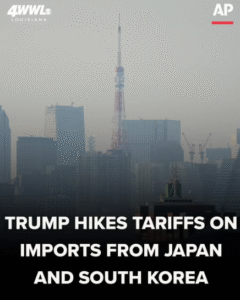Former President Donald Trump has announced the implementation of a 25% tariff on a wide range of products imported from Japan and South Korea. The move is part of a broader strategy aimed at reshaping global trade dynamics and reducing what Trump describes as unfair economic practices that disadvantage the United States. The tariffs are set to go into effect on August 1, 2025, giving the affected countries a limited window to negotiate or offer concessions.
Trump claims the tariffs are “reciprocal” in nature, arguing that both Japan and South Korea have long benefited from trade imbalances with the U.S., particularly in the automotive, electronics, and steel sectors. He stated that the United States is no longer willing to tolerate what he views as one-sided economic relationships. According to administration estimates, the U.S. trade deficit with Japan currently stands at over \$69 billion, while the deficit with South Korea is approximately \$66 billion.
The announcement sent shockwaves through international markets. Major indexes in Asia and the U.S. dipped following the news, with automotive stocks and consumer electronics companies seeing sharp declines. The Japanese yen weakened against the U.S. dollar, while South Korea’s currency, the won, remained volatile. U.S. tech and manufacturing sectors, many of which depend on imported parts and raw materials from East Asia, expressed concern over rising costs and potential supply chain disruptions.
Japanese and South Korean officials have expressed deep disappointment and concern over the sudden tariff imposition. Japan’s Prime Minister called the move “regrettable” and said it could damage a vital strategic alliance. South Korean trade officials warned the tariffs could violate existing international trade agreements and promised to explore legal and diplomatic options. Both countries are expected to send delegations to Washington for urgent talks in the coming weeks.
Domestically, Trump’s move has sparked a mixed reaction. Supporters argue that the tariffs are a long-overdue correction to trade policies that have hollowed out American manufacturing and empowered foreign competitors. They see it as part of Trump’s broader effort to bring jobs back to the U.S. and make the country more economically self-reliant. Critics, however, warn that the tariffs could lead to retaliation from trading partners, drive up consumer prices, and isolate the U.S. from key allies at a time of growing global instability.
Economists are divided on the likely impact. Some say the tariffs could give short-term boosts to domestic industries, especially steel and auto manufacturing. Others caution that long-term consequences could include reduced foreign investment and a slowdown in global trade. There is also uncertainty about how these tariffs will interact with existing multilateral trade frameworks and whether the World Trade Organization will become involved.
As the August 1 deadline approaches, pressure is mounting on all sides to find a resolution. Whether the tariffs remain in place, are reduced through negotiations, or trigger a broader trade conflict remains to be seen. For now, Trump has once again inserted himself into the center of global economic policy, with high stakes for American consumers, businesses, and foreign relations.


